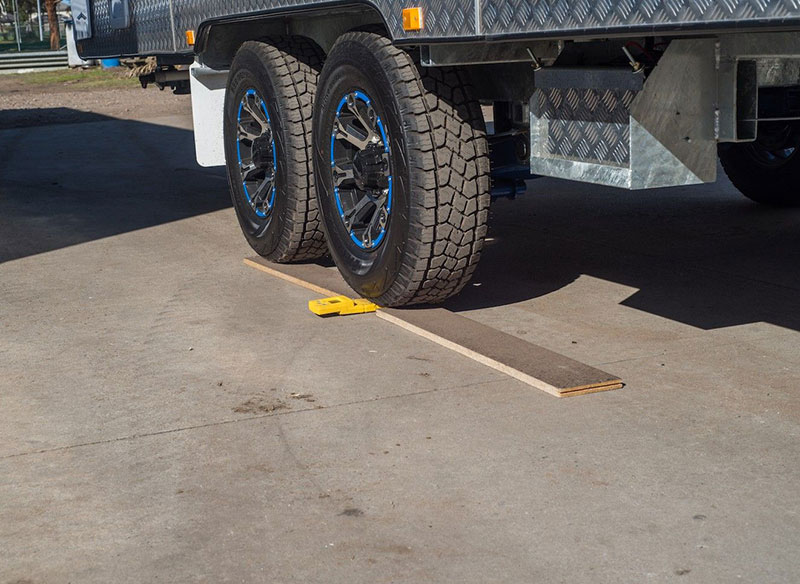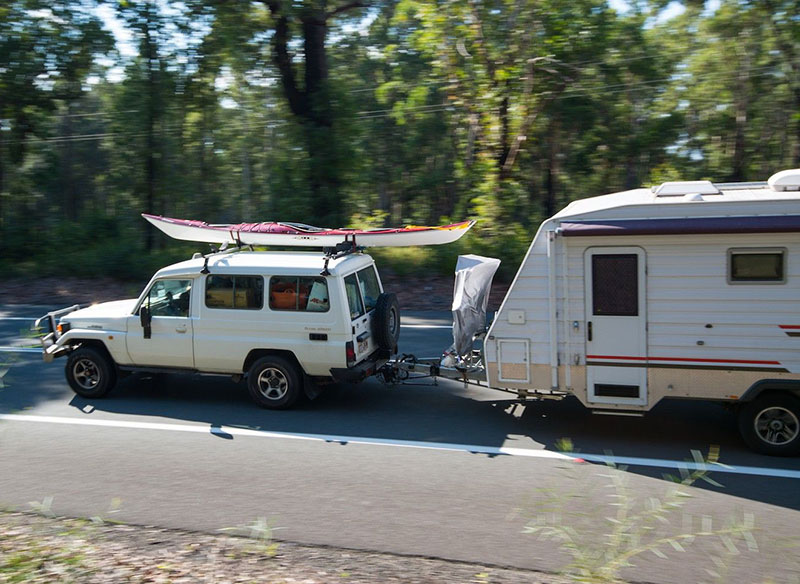This article originally featured in NRMA's Australian Caravan and RV Magazine in 2017.
I’m going to guess that almost all of us reading this article have no real idea how much our car and caravan weigh.
It’s just not that easy or practical to find out. Let’s be honest, very few of us, just as we’ve packed the van and are ready to head off on our next trip, want to detour past a weighbridge on the off-chance we’re overweight, and will then have to delay our trip to sort it out. As the saying goes, ignorance is bliss. But is it?
Weight aware
Back in January 2017, Victoria Police launched a two-day operation where officers at a roadside stop weighed 71 caravans and camper trailers to see if any were overweight. They found 41 of them were when compared with the weights specified on the compliance plate. Acting Sergeant Graeme Shenton left an extensive overview of the operation in a follow-up post on caravanersforum.com.
Of those 71, only two drivers actually knew how much their trailer and car weighed, and only three had ever bothered to check. Apart from those three, Acting Sergeant Shenton reported that every single driver underestimated what their caravan weighed.
If those figures are indicative, it says that just about everyone reading this can’t confirm they’re towing their caravan legally and 57 per cent aren’t. That’s a sobering thought.
So what can be done to solve the problem of weight awareness? Firstly, we need to understand all of the relevant caravan weights. Nearly every new caravanner has a question about the difference between aggregate trailer mass (ATM) and gross trailer mass (GTM), or the significance of towball download.
The difference in weights
ATM is the caravan equivalent of gross vehicle mass. It’s the maximum permissible mass a caravan can weigh, once it has been fitted with all accessories, travelling gear and fluids such as water and gas. In no towing situation can it weigh more than this manufacturer-stated mass. For example, if your caravan’s ATM is set at 2500kg, it can’t be towed if it weighs 2650kg, even if the car’s towball supports 150kg of weight.
Gross vehicle mass (GVM) is the maximum permissible mass a car can weigh once it has been fitted with all accessories, travelling gear, fuel, personal items and passengers, and includes the towball download of any trailer it’s towing. In no driving situation can it weigh more than this.
Towball download, often called ‘towball mass’, is the weight a caravan’s towball will put on a tow bar. When caravan manufacturers quote it, expect that to be when the caravan has just come off the production line, although that quoted number will change as soon as you load anything into or onto the van.
Gross trailer mass (GTM) is simply the ATM minus the towball download. As long as this number is lower than the caravan’s axle capacity, you can ignore it. If it’s higher than the axle capacity, buy another caravan. In some rare cases, the GTM can also mean your caravan has a minimum towball weight – for example, if your GTM and axle capacity are the same, you would be overloading the axles if your caravan is loaded so that there’s less towball download than what the manufacturer quoted.
According to the Caravan Industry Association of Australia (caravanindustry.com.au), tare weight should be the “rating specified by the caravan manufacturer for the total weight of the caravan with all options and fittings as supplied by the manufacturer with empty water tanks, gas bottles and no fluids essential for operation on public roads, and without luggage of personal effects”. But evidence suggests this isn’t always the case and often the manufacturer quotes the tare weight before options are fitted and it might be the average weight of vans produced – not specifically the weight of your own van. If you didn’t see it weighed, don’t trust it.

The difference in capacities
Load carrying capacity is the difference between the real-life tare weight and the manufacturer-stated ATM. Some caravans may state a load carrying capacity on the compliance plate, but unless you have verified the weight of your van when empty, it should be considered, at best, a guess and, at worst, your ticket to a ticket.
Maximum unbraked towing capacity is the limit your vehicle can tow if the trailer isn’t fitted with its own braking system. In most cases, this is 750kg, although some smaller cars can have lower limits.
Maximum braked towing capacity is the limit your vehicle can tow if the trailer is fitted with its own braking system. Despite common misconceptions, this isn’t specifically related to the trailer’s aggregate trailer mass, but the physical real-life weight of the trailer when you’re towing it. For example, a car with a towing capacity of 2500kg can tow a caravan with an ATM of 3000kg, as long as the van doesn’t weigh more than 2500kg when it’s being towed.
Gross combination mass is the most confusing of all masses, as it’s the maximum allowable weight of your car, caravan and all people and personal effects loaded into or hitched to the car. The vehicle manufacturer sets it and it isn’t necessarily the sum of your car’s GVM and caravan’s ATM.

Putting the weights into play
For example, the gross combination mass of a 2017 Isuzu D-Max is 5950kg, although its GVM is 2950kg and its maximum braked towing capacity is 3500kg, which equals 6450kg. So if the D-Max is carrying a full load of people and gear weighing 2950kg, it can only tow a caravan that weighs 3000kg.
Taking this example to the extreme, this caravan would have to have a ball weight of 0kg, otherwise it will overload the vehicle. More likely, the D-Max will have to lose 300kg of load so it only weighs 2650kg and can accept another 300kg on the towball. If this is the case, the caravan could then weigh as much as 3300kg, but only if its ATM allows it. Do you see why it gets so confusing?
If you were to tow a 3500kg caravan with the Isuzu D-Max, you can only have 480kg of load in the vehicle, rather than the 980kg of advertised load capacity. And this must include the towball download and the weight of driver. If you’re lucky, at the end of that you’ll have 40kg of spare capacity.
Secondly, we need to look at how reliable the specified weights of caravans actually are. According to the Caravan Industry Association of Australia’s technical liaison, James Field, there’s not a lot of evidence to suggest compliance plate figures are inaccurate. “We’ve heard a small number of accusations of such practice, however, under random inspection of products from specific brands, we’ve seen no evidence of this,” James says.
However, once a van leaves its place of manufacture, there’s plenty of scope for weight to be added to a van, affecting its potential payload. James notes, “There are many circumstances once the product leaves the manufacturer that can adjust the weight of the van, such as after-market modifications, customer requests through the dealership, or simple filling of the van with personal effects.”
Steven van Schagen agrees. He suggests there’s an issue with caravan dealers fitting accessories after the caravan has been officially weighed. This added weight isn’t accounted for and can mislead customers.

Testing the added weight
To find out whether this is the case, Steven and I visit Camden Caravan (camdencaravan.com.au) in Sydney’s southwest to weigh some randomly selected caravans. We want to know if the reality varies from what’s stamped on the compliance plate. Using the Reich Caravan Weight Control, we look at five different vans from different manufacturers, built between 2005 and 2017, to see if any are overweight.
I’ll admit our methods aren’t the most scientific and the Reich Caravan Weight Control, while a really helpful tool, can’t be considered as accurate as a certified weighbridge. Still, of the five caravans we weigh, only one varies from the compliance plate significantly – and it’s actually underweight rather than over. There’s certainly no evidence here of manufacturer poor practice in regards to caravan weight.
A legal ramification
But that’s not to say it doesn’t happen. In 2016, Greg Ingold, successfully pursued legal action against the company that sold him a brand new caravan. Among other issues, it weighed more than it said on the compliance plate. He told AC+RV that the manufacturer offered to send him a new compliance plate with upgraded weights, although it would have meant buying a new tow vehicle to pull it.
“To my surprise the van wasn’t registered [when I picked it up], which meant that I had to get a weighbridge ticket and brown slip here in NSW. The compliance plate on the van then doesn’t match up with the weight of the weighbridge ticket. I also measured the ball weight and it’s different too. If this is true, then I’m up for another tug vehicle, which is going to stretch the budget way too far. Also I noticed that on the compliance plate there’s a place for tyre pressure – this is blank and they have stamped rim size where it states tyre size. Should these spaces on the compliance plate have stamped what is required? I phoned the manufacturer regarding the weights, and they said to let them know and they will send up another compliance plate for me to affix to the van. I questioned them and they said they do it all the time.”
After a year of legal battles, he was given a full refund of $67,000.

More needs to be done
But that’s just one example and I’m sure it’s not the only one from 2015 when Greg bought his caravan. Over 20,000 caravans were built and sold in Australia that year. But the evidence strongly suggests that manufacturers are meeting their obligations in regards to weight.
With this being the case, unfortunately we may have to accept that the problem lays with us caravanners. If caravans are coming out of the factory compliant and are being towed along the road overweight, then those of us towing them have to take responsibility for it. Just like it’s our responsibility to stick to the speed limit while driving, we have to stick to the weight limits of our vehicles.
However, the industry and manufacturers could certainly make that easier for us. Work is already being done at an industry level. James Field says, “In 2016, the Caravan Industry Association of Australia conducted over 700 compliance reviews on new recreational vehicles at manufacturing premises, in retail dealerships and at consumer shows, and is set to conduct in excess of 1000 reviews within the 2017 calendar year. As part of this process, we’ve also introduced a payload calculator to assist manufacturers in accurately accounting for payload, and are in development for a weight distribution tool for industry businesses to better understand caravan configuration and how to improve towing safety and efficiency.”
But more needs to be done. There’s little doubt a caravan with only a small payload of 300kg – before anything like an awning or an air conditioner or second water tank is added – is as good as useless. Caravan builders need to get more serious about weight reduction strategies that lead to payload increases and to take into account the possibility of additional accessories being added down the track. It’s not hard to find out how much a Dometic awning or AirCommand air conditioner weighs, so give us that payload capacity, just in case.
Moreover, retailers need to be more diligent when selling caravans to consumers. If a caravan dealer knows that accessories have been added after the compliance plate has been stamped, they should be offering full disclosure on what they are and how they will affect payload. This is so buyers can make informed decisions and adhere to the law.











